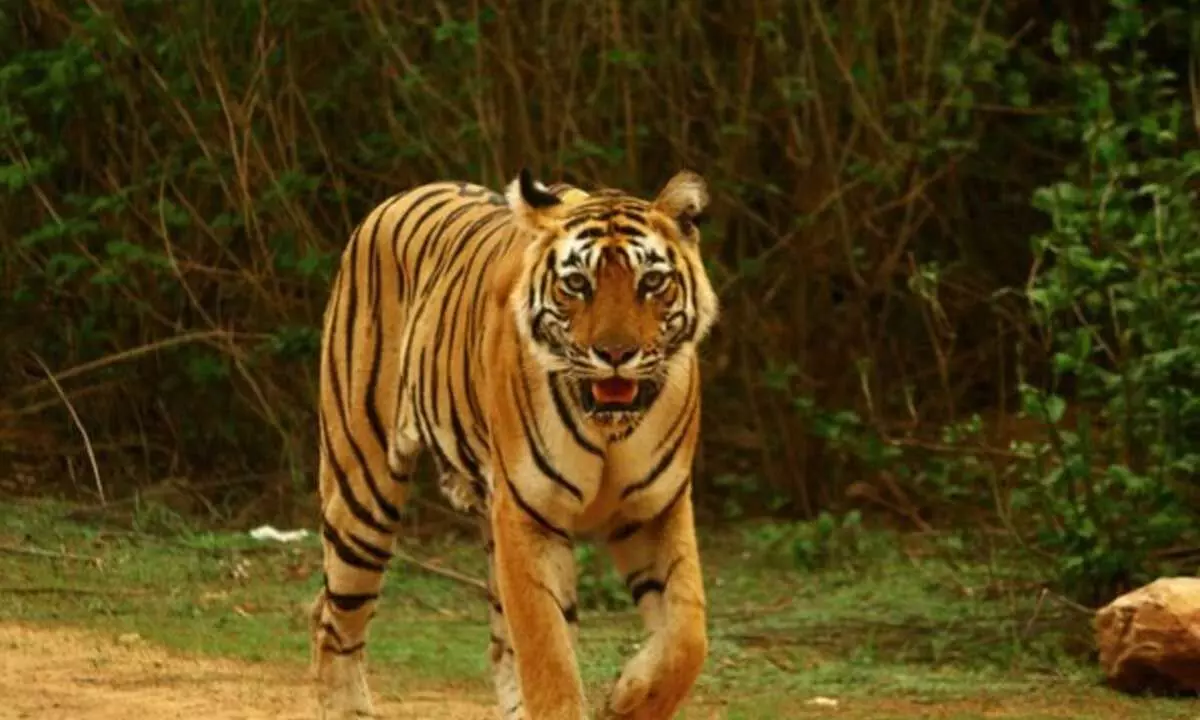Live
- WPL 2025: Matthews, Sciver-Brunt and Harmanpreet carry MI to massive 213/4
- MLA Anirudh Reddy Accuses KTR of Involvement in Manhattan Project Scam
- TGPSC Clarifies on False Propaganda Regarding Group-1 Recruitment
- Hyderabad Police Ensures Security as Holi and Ramadan's Second Friday Coincide
- Five MLCs Elected Unopposed in Telangana Under MLA Quota
- Sambhal prepares for a peaceful Holi with tightened security and special patrols
- CNG, PNG prices to become cheaper in Rajasthan from March 14
- Anti-Rape ad to screen in theaters before movies, like health advisories
- Prodigy Finance Offers Three Scholarship Awards totalling an amount of $19,000 for Global Students Starting Fall 2025
- Champions League drama likely to affect La Liga with big games this weekend
International Tiger Day 2024: History, Famous Quotes by PM Modi, and India's Most Renowned Tigers and Tigresses


International Tiger Day, celebrated annually on July 29, aims to raise awareness about the conservation of these majestic yet endangered big cats.
International Tiger Day, celebrated annually on July 29, aims to raise awareness about the conservation of these majestic yet endangered big cats. The primary goal of this day is to establish a global framework to protect the natural habitats of tigers and garner public support for tiger conservation efforts.
History of International Tiger Day
International Tiger Day was established in 2010 during the Saint Petersburg Tiger Summit in Russia. This summit brought together 13 tiger range countries to address the alarming decline of the wild tiger population, which had decreased by 97% since the start of the 20th century. The participating nations committed to the Tx2 initiative, which aims to double the tiger population from 3,200 to at least 6,000 by tackling issues such as habitat loss, poaching, and human-wildlife conflict.
India’s 10 Most Famous Tigers and Tigresses
1. Machli, Ranthambore National Park
Known for the fish-shaped mark on her cheek, Machli, the Tigress Queen of Ranthambore, significantly boosted India's tiger population by giving birth to 11 cubs between 1999 and 2006. She helped increase Ranthambore’s tiger count from 15 to 50. Honoured with a commemorative postal cover and stamp in 2013, Machli passed away in 2016 at the age of 19, the longest any wild tigress has lived.
2. Collarwali, Pench National Park
Collarwali, the only tigress in the wild to have given birth to 29 cubs, earned her name as the first tiger in Pench to be fitted with a radio collar. Known as Mataram (beloved mother), she played a vital role in the park’s tiger population growth.
3. Maya, Tadoba-Andhari Tiger Reserve
Reigning supreme in Tadoba National Park, the oldest national park in Maharashtra, Maya is famous for her clashes with other tigresses. These battles highlight the challenges of shrinking tiger habitats and survival struggles.
4. Paro, Corbett Tiger Reserve
First sighted in Corbett around 2013-14, Paro, possibly the daughter of Thandi Maa from Dhikala Chaur, established her rule over both sides of the Ramganga river despite her petite size by chasing away two tiger matriarchs.
5. Vijay, Delhi Zoo
The six-footer white tiger Vijay became well-known for attacking a 22-year-old intruder. He played a key role in the zoo’s successful breeding program, siring five cubs with his mate Kalpana.
6. Munna, Kanha National Park
Known as the King of Kanha, Munna is famous for the distinctive stripes on his forehead. Though he is now old, his tales of territorial fights remain popular. His legacy continues with his son, Chota Munna, in Kanha.
7. Prince, Bandipur National Park
A dominant male tiger, Prince was the most photographed and dominant tiger of Bandipur Tiger Reserve in Karnataka. His body was found in 2017 in the park’s Kundakere Range.
8. Waghdoh, Tadoba-Andhari Tiger Reserve
Named after a waterhole in the Mohurli region of Tadoba, Waghdoh established his territory by defeating another tiger, Yeda Anna. He was found dead in May 2022, shortly after reportedly killing a shepherd.
9. Kankati, Bandhavgarh National Park
Also known as Vijaya, Kankati dominated the Chorbehra and Chakradhara regions up to the Bandhavgarh Fort. Her fierce battle with Lakshmi, a disabled tigress, left her with one eye. Her story is detailed in Shivang Mehta’s book, "A Decade with Tigers: Supremacy, Solitude, Stripes."
10. Bamera, Bandhavgarh National Park
Bamera, the largest tiger the park had ever known, ousted his ailing father (B2) and became the dominant male of Bandhavgarh National Park.
PM Modi’s Famous Quotes on International Tiger Day
1.“For wildlife to thrive, it is important for ecosystems to thrive. This has been happening in India.”
2.“Protection of wildlife is a universal issue.”
3.“Human empowerment is incomplete without a better environment. And so, the way ahead is in collectiveness instead of selectiveness. We need to take a broad-based and holistic look at environmental conservation.”
4.“India has not only saved the tiger but has also given it an excellent ecosystem to flourish.”
5.“We do not believe in conflict between ecology and economy, but give importance to co-existence between the two.”

© 2025 Hyderabad Media House Limited/The Hans India. All rights reserved. Powered by hocalwire.com






